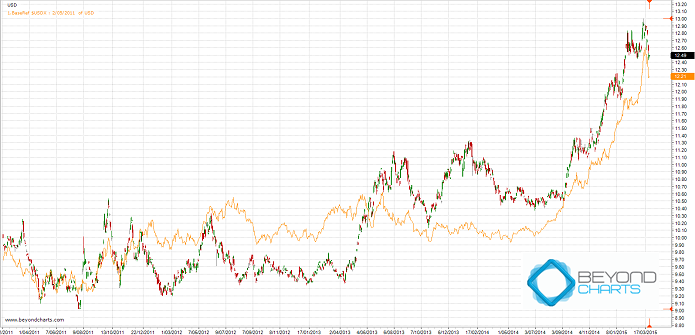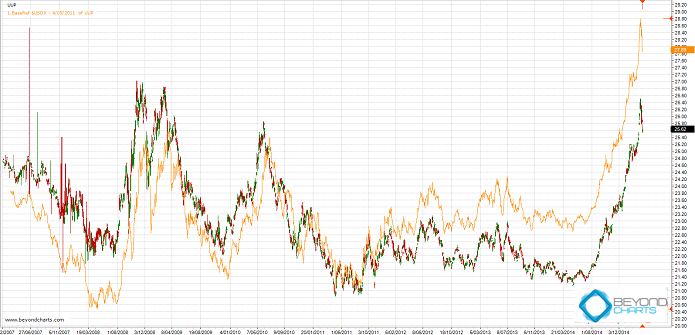In my earlier postings on the use of ETFs by investors, I wrote that some of the major benefits of ETFs for the ordinary investor included the fact that they can be traded in your share trading account and as a result allow for portfolio diversification. This week I would like to look at this from a slightly different angle, using the US dollar ETF for a number of purposes.
As shown in the chart below, over the past 7 months the US dollar has had a remarkable run, and has been the talk of most market analysts, traders and investors alike. The first chart is that of USD, an ASX listed ETF that tracks the US Dollar Index ($USDX), which is a basket of currencies measured against the US dollar. The second is the UUP, the US listed ETF which also tracks the US Dollar Index.
Both charts have the US Dollar Index overlayed to compare the relative movements.
Whilst those with futures market experience and accounts, or those trading FX, may have participated in this bull market, the vast majority of share traders have only watched on as the “Big Dollar” (as it is referred to by futures traders) has soared in value by around 22%.
However, trading the US Dollar is available to share traders through the use of ETFs. This means that those interested in trading the US dollar are able to do so through their share trading accounts using either the US listed ETF – code UUP, or the ASX listed ETF – code USD.
The main difference between the ETF approach and trading the futures or spot FX market is that the ETF approach carries no leverage. Of course you could leverage if you wished to via CFDs or a Reg-T Margin account for the USA listed UUP.
You can apply your technical analysis skills to this market in the same way you apply them to arriving at buy and sell decisions for any listed stock.
It wasn’t so long ago that individuals used travellers cheques to hedge against their home currency – I can remember doing this. Or opened a US dollar banking account in Australia, or their home country, and deposited A$ into the $US account. Businesses that imported goods had to take out forward cover with banks at high premiums to cover exchange rate variation between the order date and delivery date. All this has changed and ETFs offer a valid option for achieving the same outcomes without leverage.
The ability to access this and other ETFs also provides the potential for diversification within your portfolio as you are now not limited to only trading and investing in shares. You have the ability from within the one account, to access a huge range of ETFs across a broad range of markets.
There are countless other examples of the benefits of using ETFs for the vast majority of active investors. Next week we will take a look at using ETFs over a major global stock market index that has also had a phenomenal run over the past few months.




